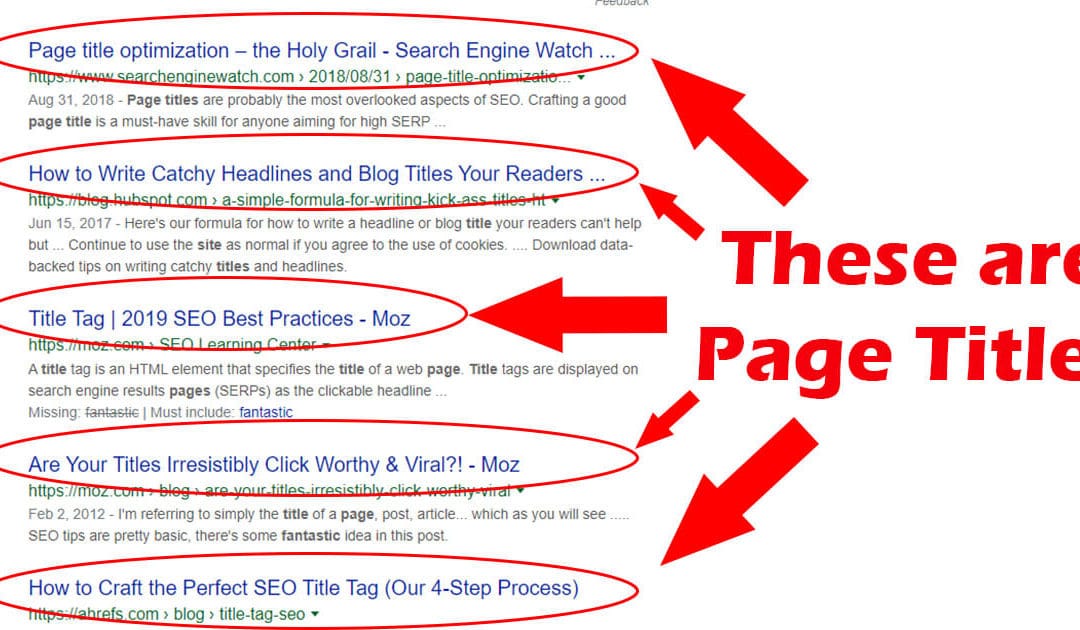When I sit down with people and ask them to identify the title of a webpage they usually point to the biggest text on the screen. If they were looking at this page, they’d point to the name of the article just below the logo: “On Page SEO Basics: Titles”. That’s a header, but it’s not the page title.
The actual title of this page is “Webpage Title Secrets to Improve SEO and Clickthroughs | The Web For Business.com”. Where can you find this? Look waaaaay at the top of the page (on a desktop or laptop) and look at the text in the tab you’re viewing this webpage in. That’s where the page title shows up on a webpage.
If you happen to be looking at the HTML code of a page, you’ll find the title near the top. It’s nestled between the <title> and </title> tags. Remember the “old days” when people used to talk about the importance of “meta tags”? The <title> tag is one of those meta tags.
What you put in your title is important for a few reasons.
Title Text is Displayed on Search Engine Results Pages
In the image above you’ll see text in blue. Those are the page titles. I’ve added red ellipses and arrows to highlight them.
When viewed this way, you can see why titles are important. They are the first thing about your website that a searcher sees. If the title is intriguing or relevant to the searcher’s needs, they’ll be more likely to click on the title to visit the webpage. While the title text isn’t easily seen on your webpage, it’s displayed in an even more important place on the search engine results pages where it’s the first thing potential visitors see about you.
Search Engine Algorithms Look at Titles
We all know search engines have changed a LOT since they were first introduced. One thing that hasn’t changed in their many algorithm updates is they still look at the title of the page. The role of a title has always been to let people know what the page is about so search engines still look at them. If the title doesn’t match the rest of the content on the page, you’re not doing yourself any favours with Google.
Social Media Platforms Display Page Titles
By default most social media platforms display the title text of a webpage when you share the link. Having a page title like “Home” or “About Us” doesn’t grab people’s attention and social media’s all about grabbing attention. Having a good page title can be the difference between being ignored and getting a new website visitor.
SEO Title Tag Best Practices
Writing a good page title is like writing a good headline: it’s an art and it takes time. Here are some basic principles you should follow when you’re starting to craft your page titles.
Titles Are For Humans First, SEO Second
While the title is important for SEO, it’s more important for human readers. A great title can help your page rank #1 in the search engine results but if nobody clicks on it, your top ranking won’t matter. Write a title that you would want to click on.
Short, Relevant, Targeted Titles are Better
Most search engines have a character limit when it comes to displaying titles. You can write a paragraph as your title if you want but only the first 60~70 characters will be displayed. Google limits page titles to 600 pixels wide so the character limit may vary.
Keeping your title short means the whole thing can be displayed on the search engine results pages. If you can keep it concise and focused on your target audience’s needs you’ll be more likely to have it read and clicked on.
Use Unique Titles on Every Page
Maybe you have a dozen pages on how to knit different sweater patterns. That’s fine, as long as you give each page a different title. Having a dozen pages titled “Knitted Sweater Pattern” doesn’t tell visitors or the search engines enough detail to distinguish between them. Give potential visitors more detail. Here are some examples:
- Cable knit maternity sweater pattern
- Pullover knitted sweater pattern
- Textured striped knitted sweater pattern
- Cowl neck knitted sweater pattern
- and so on . . .
These are basic suggestions on how to optimize a page’s title tag. It’s not rocket science, but it’s surprising how often it is overlooked when sites are designed and launched. You may think your website designer will take care of it but I’ve seen a disappointing number of professionally-designed websites that have page titles like “Home”. Following these basic principles of page title writing can help you achieve better rankings and higher clickthroughs by potential customers.
Thanks for reading today’s article on the importance of the title tag for SEO and clickthroughs! Please let us know what you thought by leaving us a comment below. Join us tomorrow as we discuss another important meta tag!


Thank you. This is timely. I’ll review my blog page titles to ensure they meet these principles.